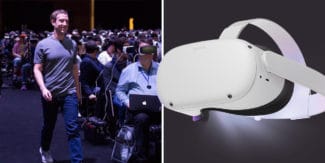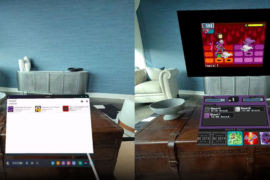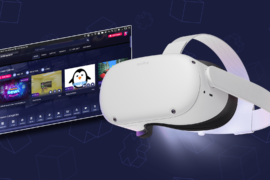Facebook’s Oculus Quest 2 is one of the best headsets available on the market. It also requires a Facebook login, and agreeing to Facebook’s terms of service for the device.
Here’s our outline of what you’re committing to when using a Facebook headset — including what logging in with Facebook means, how your personal data and information is being used and what access Facebook has to the real time data of your headset.
History and Context

For those who are unaware, here’s a brief contextual overview for the information listed below.
In 2014, Facebook acquired Oculus, the virtual reality startup company started by Palmer Luckey, for approximately $3 billion. Despite insisting that Oculus still would operate somewhat independently from Facebook, the Oculus branch of Facebook slowly but steadily became a bigger part of the Facebook ecosystem and less of its own entity.
Up until recently, owners of an Oculus headset could simply log in with an Oculus ID/account when using their device — no direct Facebook association required. It was possible to link your Facebook and Oculus accounts together for social features, but it was never mandated and remained an optional feature. However, over time, this began to change.
In May 2018, Facebook required that users would need to link their Facebook and Oculus accounts together in order to access Oculus Venues.
In December 2019, Facebook stated that Oculus VR data would be used to provide “more relevant content” like ads on Facebook if your Facebook and Oculus accounts were linked.
Facebook announced its most recent headset, Oculus Quest 2, in September 2020. However, it also announced that the device requires a Facebook login — without logging in with Facebook, there is no way to use and access the headset. All new first-time sign-ins on any Oculus device would require the user to log in with a Facebook account. Users who already owned a headset before October 2020 and are using an Oculus account without a linked Facebook account will only be able to do so until the end of 2022, at which point Facebook will fully end support for Oculus accounts. Facebook says it plans to share details about how those account owners will be able to access their purchased content after that date.
Logging in with Facebook

As outlined above, all first-time sign-ins on any new Oculus headset now requires logging in with a Facebook account. If you are setting up a headset for the first time, you will have to log in with a valid Facebook account. Standalone Oculus accounts are still supported for users who set up a headset before October 2020 and chose not to link their Facebook account, however it is no longer possible to create an Oculus account for your headset. Logging in with Facebook is the only option.
This also means that your access to the headset is also dependent on access to your Facebook account. If access to your Facebook account is revoked, so too is access to your headset. Likewise, your Oculus purchases are tied to your Facebook account. If you delete your Facebook account permanently, you also lose access to all your purchased content associated with that account for good.
According to the company’s terms and conditions, your Facebook account, which you would use to log into an Oculus device, “must… use the same name that you use in everyday life.” You also cannot use Facebook if your account was previously disabled for violations of Facebook terms and policies.
Despite logging in with Facebook, you can still have an ‘Oculus ID’ as your display name for games and apps. This allows you to remain somewhat private while playing online or taking part in social services like Facebook Horizon.
Facebook Account Requirements

There are also some things to watch out for in regards to the Facebook account you use to log in to your headset with.
Firstly, you want to make sure you are using a ‘real’ account that has your real name — there have been reports of users being suspended when they tried to use or link an account that was a ‘dummy’ account (a fake account created that uses a fake name and incorrect or made-up details) or an account that was not their primary Facebook account. Facebook can change its detection systems at any time, so it is possible for those who do create such an account to be caught years in the future.
Around the release of Quest 2, a small number of users had their accounts banned in what appeared to false positives, completed automatically by the account verification system. The same also reportedly happened to some users trying to reactivate an old Facebook account, or some people who had just made a brand new account as well. We believe the process to reverse the ban involves manual human-approval, which is often lengthy and requires some kind of photographic proof of identity.
It’s worth noting that the vast majority of Facebook users who linked an Oculus Quest device remain unaffected by this automatic ban process and experience no issues. That being said, a small percentage of Quest users have been affected due the reasons above (and likely other unreported reasons too). You can read more in our report detailing all the issue from October last year.
In response, Vice President of Augmented and Virtual Reality at Facebook, Andrew Bosworth, said that it was only a “small number” of users were affected but that “people should continue to make sure their Facebook accounts are in good standing before they buy the headset.” You can read his full response here.
On-Device Headset and Tracking Data

Some users would be understandably concerned about linking their Facebook account to a device that tracks human movements and uses four external cameras at all. However, Facebook repeatedly assures users that they do not collect or store Oculus Quest camera or guardian data.
Facebook’s tracking system uses data from the cameras to create a 3D map of the world — while the camera imagery is not stored in any way, a 3D cloud of points identifying the placement of unique static features of the environment is saved locally on the headset for any room where you have a Guardian boundary set up. This allows the system to recognize what room you’re in and load the Guardian boundary you previously created. Facebook tells us that this data doesn’t leave the local device.
The Oculus Quest headsets also have a small white light on the top of the headset which is “hard-wired to the sensor power rail.” This means that whenever the camera sensors are supplied with power, the light should turn on. You can learn more about the Facebook’s camera tracking system here.
Activity Data and Ads
While Facebook says that on-device data such as the camera imagery does not leave the device, this is not the case for some activity and content data. In December 2019, Facebook confirmed that your activity on an Oculus device, such as which apps you use, will be used to target “relevant content” to you, such as ads or Facebook events. For example, Facebook might collect data of which VR apps you’ve been using on your device and then target you with suggestions for “Oculus Events you might like to attend or ads for VR apps available on the Oculus Store” while you’re using Facebook.
In late December 2020, Facebook’s head of its efforts in VR and AR wrote notes to employees outlining a potential shift to the company’s direction on privacy. Andrew Bosworth wrote how he wanted the company differentiate itself on the basis of privacy while “holding a higher bar for sending data to the server than we do for processing it locally.”
“I don’t want us to just meet the consumer expectations for privacy today,” he wrote. “I want us to differentiate our products on the basis of privacy. Let other companies scramble to keep up with us.”
Any questions on Facebook logins, user data and privacy on Oculus headets? Let us know in the comments and we’ll try to clarify as best we can.





